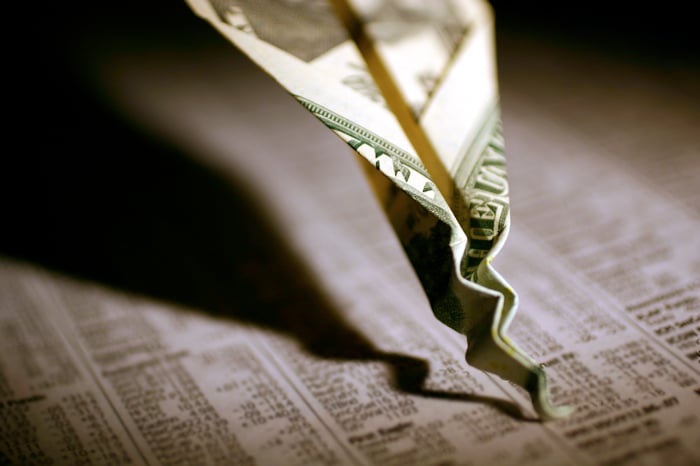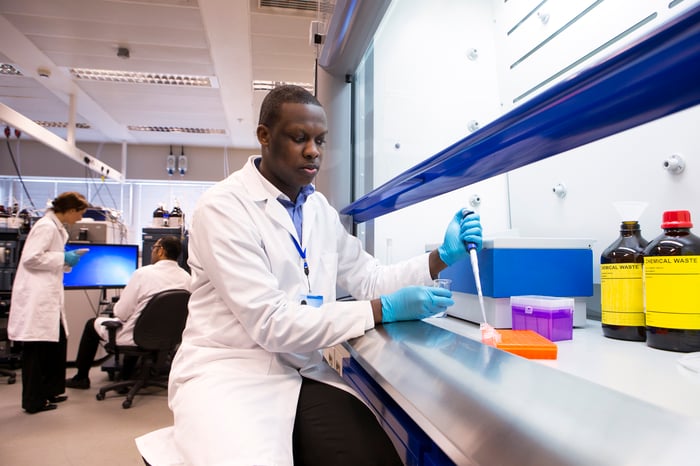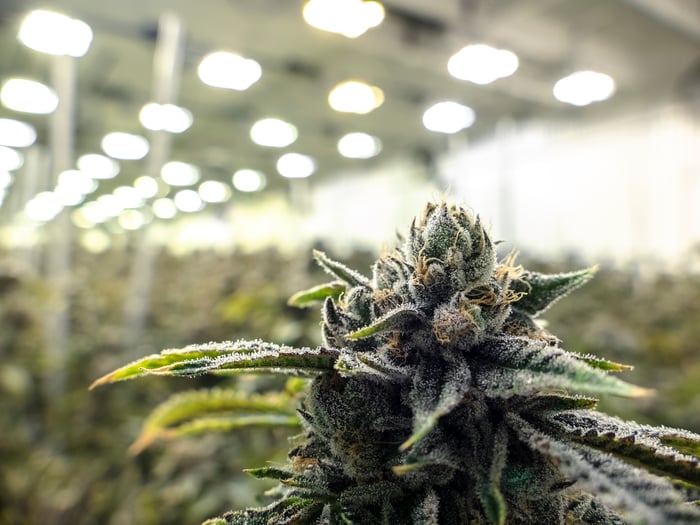Patience has paid off handsomely for investors since the coronavirus pandemic began. Despite the benchmark S&P 500 (^GSPC 0.02%) losing a third of its value in roughly a month during the first quarter of 2020, the index has since more than doubled.
However, double-digit corrections and stock market crashes are a normal part of the investing cycle. Given a number of variables, there looks to be a growing likelihood of downside in the S&P 500.

Image source: Getty Images.
All signs point to a growing possibility of downside in the broader market
As an example, margin debt hit an all-time high earlier this year and jumped by more than 60% from the prior-year period. Margin debt describes the amount of money borrowed with interest to buy or short-sell securities. Since 1995, there have only been two other instances where margin debt outstanding rose by at least 60% in a given year: Right before the dot-com bubble burst and months before the financial crisis began.
Beyond just margin debt, there are valuation concerns. Admittedly, the advent of the internet and the democratization of online trading with the removal of commission fees has helped expand earnings multiple over the past quarter of a century. However, this doesn't negate that the S&P 500's Shiller price-to-earnings (P/E) ratio is in rarified territory.
This past week, the Shiller P/E, which examines inflation-adjusted earnings over the last 10 years, closed above 40 for the first time in almost two decades. Aside from being well over double the 151-year average, there's the precedent that the S&P 500 lost at least 20% of its value following the previous four instances of the Shiller P/E crossing above 30.
Even history suggests the market will head lower. Following each of the previous eight bear-market bottoms, dating back to 1960, the S&P 500 has endured one or two declines of at least 10% within 36 months. What this tells investors is that rebounding from a bear market is a process that often has many bumps in the road. Thus far, the bounce back from the pandemic bottom has been a virtual straight shot higher.
All signs would appear to point to an upcoming stock market crash or sizable correction.

Image source: Getty Images.
Crashes and corrections are the perfect time to buy dividend stocks
On the flipside, crashes and corrections have always represented an opportunity for long-term investors to go shopping for great companies at a discount. After all, every crash or correction throughout history has eventually been put in the rearview mirror by a bull-market rally.
Perhaps the smartest pathway to riches during a crash or sizable correction is to buy dividend stocks. Companies that parse out a regular dividend are often profitable and time-tested, which makes them perfectly suited to help you navigate short-term stock market downside.
If a crash or steep correction does materialize, the following three unstoppable dividend stocks would be ripe for the picking.
AGNC Investment Corp.: 8.9% yield
First up is ultra-high-yielding mortgage real estate investment trust (REIT) AGNC Investment Corp. (AGNC -0.11%). AGNC is currently paying out almost 9% annually, and has averaged a double-digit yield for 11 of the past 12 years.
Mortgage REITs like AGNC Investment are highly interest-sensitive. Their goal is to borrow money over the short run at the lowest rate possible, while acquiring mortgage-backed securities (MBS) that'll pay a higher yield over the long term. The difference between the average yield from MBSs minus the average borrowing rate is known as the net interest margin. The wider this margin, often the more profitable mortgage REITs can be.
Look back six decades and you'll note a trend. When the U.S. economy bounces back from a recession or bear market, it's very common for the Treasury yield curve to steepen -- i.e., long-maturity bond yields rise while short-term yields flatten or decline. This scenario tends to boost the net interest margin for mortgage REITs.
Furthermore, AGNC almost exclusively buys agency-backed MBSs. An agency asset is protected by the federal government in the event of a default. Although this added protection does lower the yield AGNC nets on its MBSs, it also allows the company to utilize leverage in order to increase its profit potential.
With AGNC Investment Corp. trading modestly below its book value and entering the sweet spot of its growth cycle, it represents a perfect example of an unstoppable dividend stock to buy on substantial market weakness.

Image source: Getty Images.
Bristol Myers Squibb: 3.3% yield
Another unstoppable dividend stock investors can confidently buy during a crash or correction is pharmaceutical company Bristol Myers Squibb (BMY -0.27%).
The great thing about healthcare stocks is that they're generally (pardon the pun) immune to short-term market vacillations. Since we don't control when we get sick or what ailment(s) we develop, there's always demand for drugs, devices, and healthcare services in any economic environment.
More specific to Bristol Myers Squibb, it's benefiting from a healthy combination of organic and inorganic growth. Beginning with the latter, it acquired cancer and immunology drugmaker Celgene two years ago. Although this buyout brought in a number of blockbuster therapies and dozens of clinical-stage partnerships, it's multiple myeloma drug Revlimid that's moving the needle.
Revlimid's sales have soared for more than a decade as a result of label expansion, longer duration of use, improved cancer screening diagnostics, and strong pricing power. This key drug should make a run at $13 billion in full-year sales in 2021, and is protected from a full wave of generic competitors through January 2026.
From an organic standpoint, Bristol Myers Squibb has consistently hit home runs with its oncology and cardiovascular products. Oral anticoagulant Eliquis is on pace to top $10 billion in annual sales this year, while cancer immunotherapy Opdivo produced $7 billion in revenue last year. Opdivo is particularly interesting given that it's being examined in dozens of clinical-stage trials as a combination treatment or monotherapy. Already approved in 10 indications, Opdivo is a good bet to see its label expand over time.
Bristol Myers Squibb is an absolute bargain at less than eight times Wall Street's estimated earnings for 2022.

Image source: Getty Images.
Innovative Industrial Properties: 2.1% yield
A third unstoppable dividend stock investors can pile into if the stock market crashes or corrects lower is cannabis-focused REIT Innovative Industrial Properties (IIPR 0.06%).
Innovative Industrial Properties, or IIP for short, acquires medical marijuana cultivation and processing facilities with the purpose of leasing these assets out for an extended period of time (often 10 to 20 years). While acquisitions are the company's primary means of growing revenue, IIP does offer a modest organic growth component. Every year it passes along an inflationary rental increase, and collects a 1.5% property management fee that's based on the annual rental rate.
As of Nov. 3, IIP owned 76 properties spanning 7.5 million square feet of rentable space in 19 states. The most important number here is that 100% of its rentable space is leased, with a weighted-average remaining lease length of 16.7 years. Though the company no longer reports its average yield on invested capital, I'd surmise it'll take less than seven years for IIP to fully recoup what it's invested.
Innovative Industrial Properties' "secret weapon" is its sale-leaseback program. With many pot companies running into financing issues due to marijuana's scheduling at the federal level, IIP has turned into a financier, of sorts. With the sale-leaseback program, IIP buys facilities with cash and immediately leases these assets back to the seller. This nets pot companies the cash they so desperately need, while securing a long-term tenant for IIP.
As one final note, don't be disappointed by Innovative Industrial Properties' 2.1% yield. IIP has grown its quarterly payout by 900% in four years, and the company's shares have gained almost 1,400% over the trailing five-year period. Patient investors are doing just fine, even with a "modest" 2.1% yield.





